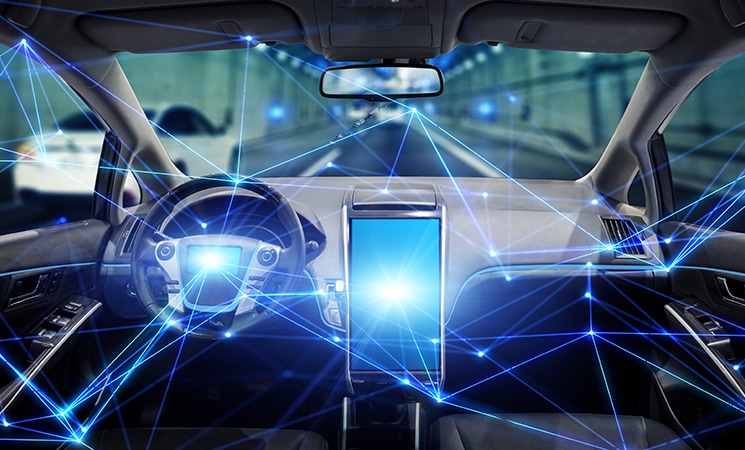The Drive Towards the Software-Defined Vehicle Built on Ethernet
Ethernet, an established, standardized technology, is rapidly evolving to support markets including automotive that have specific requirements – like the determinism and high bandwidth critical to autonomous vehicles.

The autonomous vehicle of the future will become one of the world’s most complex “mobile” devices ever created. Its complexity derives from the need for autonomous operation to process terabytes of data each day — partly drawn from a large array of sensors and devices inside, outside and around the vehicle and from the cloud — consuming teraflops (TFLOPs) of computing capacity while running a hundred million lines of software code. This is changing how engineers think about vehicles, especially about how vehicle systems talk to each other.
Autonomous Vehicles – a New Design Paradigm
The trend to automate cars over the years has resulted in a complex array of independent computers for vehicular subsystems. These systems required multiple, specialized electronic control units (ECUs), different types of buses and protocols, and gateways to translate data and signals between buses so the systems could communicate with each other. This heterogeneous approach is expensive, hard to secure against cyberthreats and, frankly, heavy. Cabling is the third most costly part of a car’s bill of materials and the third heaviest component in its build, reaching a whopping 110 pounds of copper in some cars.
The fully autonomous vehicle is a more complex system that requires large amounts of real-time data, cloud connectivity and fast, safe and secure decision-making. Compared to today’s automobiles, the amount of data moving around the car will be orders of magnitude larger and require enormous bandwidths. Autonomous driving will require more video, radar and LiDAR data processing – and these capabilities will require multiple gigabits of physical network throughput to support real-time decision making. Data logging, secure transactions and communication with the cloud will add to I/O demand.
Delivering the computing capacity and managing the complexity requires rethinking the automobile. Instead of dedicated ECUs, several distributed, zonal ECUs around the vehicle will each run millions of lines of code to process data from local end points and the cloud, and also interconnect with one or more main ECUs. Bandwidth, complexity and costs are issues that arise when trying to connect all these devices using today’s many existing network protocols and cables. 
Software-Defined Vehicle
The car is evolving as a system of software-defined functions running on distributed computing — the software-defined vehicle (SDV). The trusted standard in computing is IP-based networking built on Ethernet. Ethernet, offering a single bus for communications and eliminating the complexity of vehicle gateways and cables, has been proven to support the flexibility and performance of software-oriented architectures including software-defined networks and virtualization.
Many benefits emerge from the SDV. Software is easier and faster to update, change and improve than hardware-oriented systems. Using virtualization, the SDV becomes a much more dynamic computing environment. When an ECU begins to fail, for example, software-defined functions can quickly be moved to other ECUs across the vehicle, maintaining required functional safety levels and critical operations.
The SDV creates new opportunities for manufacturers to differentiate their products, enhance safety and improve their offerings, services, and overall manufacturing efficiencies. The SDV requires manufacturers to become software powerhouses. Manufacturers are already ‘re-tooling’ their R&D professional infrastructures to include software development teams that never existed before.
Security in the SDV
Digital security is paramount for the autonomous vehicle, a continuum that extends from the manufacturer to the owner. The many devices onboard and connectivity to passengers and the cloud vastly expand the attack surface for bad actors. Common security functions employed in the SDV will be based on open-source solutions that support secure boot, authentication, encryption (where needed), keys and key management and secure enclaves. Additionally, network-specific security services are likely to include these features:
- Virtual LANs to isolate zonal ECUs from the physical network
- Access control to allow only authorized transactions on a zonal network
- Deep packet inspection to monitor transactions and detect and block unwanted data
- Intrusion detection and prevention to stop bad actors from gaining access
In the field, updates will need to be protected against hacking, most likely through a secure chain of trust established in the production floor and ending with the vehicle’s owner.
Tools to Help Ensure Functional Safety
To enable communications in the SDV, the market needs automotive-specific physical devices (PHYs) for Ethernet and other protocols. These devices need to provide the desired bandwidths and cost and meet the functional safety requirements established in the industry and set by regulators. Microchip is a leading contributor to automotive solutions. The company’s catalog offers many “Functional Safety Ready” devices for automotive, including automotive-qualified Ethernet devices.
These devices were carefully selected to help manufacturers achieve ISO 26262 certification, with many tools that include failure mode effects and diagnostic analysis (FMEDA) report, Functional Safety Manual, diagnostics software and development tools.
All-Ethernet Vision for Autonomous Driving
The automotive industry’s vision is moving toward an all-Ethernet SDV, with internetworked zonal ECUs, sensors and devices controlled by central ECUs. This migration is easier for green-field manufacturers than established companies. Greenfield environments can go all-in immediately to allow easy adoption of an all-Ethernet approach. For other carmakers, migrating to an all-Ethernet vehicle may take time, requiring the SDV to include a hybrid network architecture of CAN, LIN, and other buses for local connectivity to certain components with a main Ethernet backbone.
Ethernet’s trusted, proven standards, high bandwidths from Mbps to Gbps and simplicity support the necessary performance, security services and easy connectivity an SDV will demand. Ethernet’s serial cabling options reduce the costs and complexities of multiple car networks, cabling and weight. Less weight can improve fuel efficiency — both electric and gasoline/diesel. And, while Ethernet is an established, standardized technology, it continues to evolve to support markets, such as automotive, with specific demands that include determinism and high bandwidth — necessities in autonomous vehicles.